Supply Chain Management Report: Tesco Case Study (MGT6801)
VerifiedAdded on 2022/12/16
|11
|3981
|2
Report
AI Summary
This report provides a comprehensive analysis of Tesco's supply chain management, as assessed for the Richmond Business School's MGT6801 module. It delves into key aspects such as customer service and inventory management, exploring how Tesco ensures product availability and utilizes inventory methods like historical data analysis and EOQ. The report examines transportation modes, focusing on Tesco's reliance on trucks for both supply and demand-side logistics, as well as the efficiency of their transportation network. Warehousing and capacity management are also scrutinized, highlighting the role of warehouses in inventory storage, distribution, and the challenges of capacity management. Finally, the report assesses Tesco's supply chain strategy, its contribution to competitive advantage, and suggests potential areas for improvement, concluding with an overview of the overall supply chain strategy and its impact on Tesco's market position.
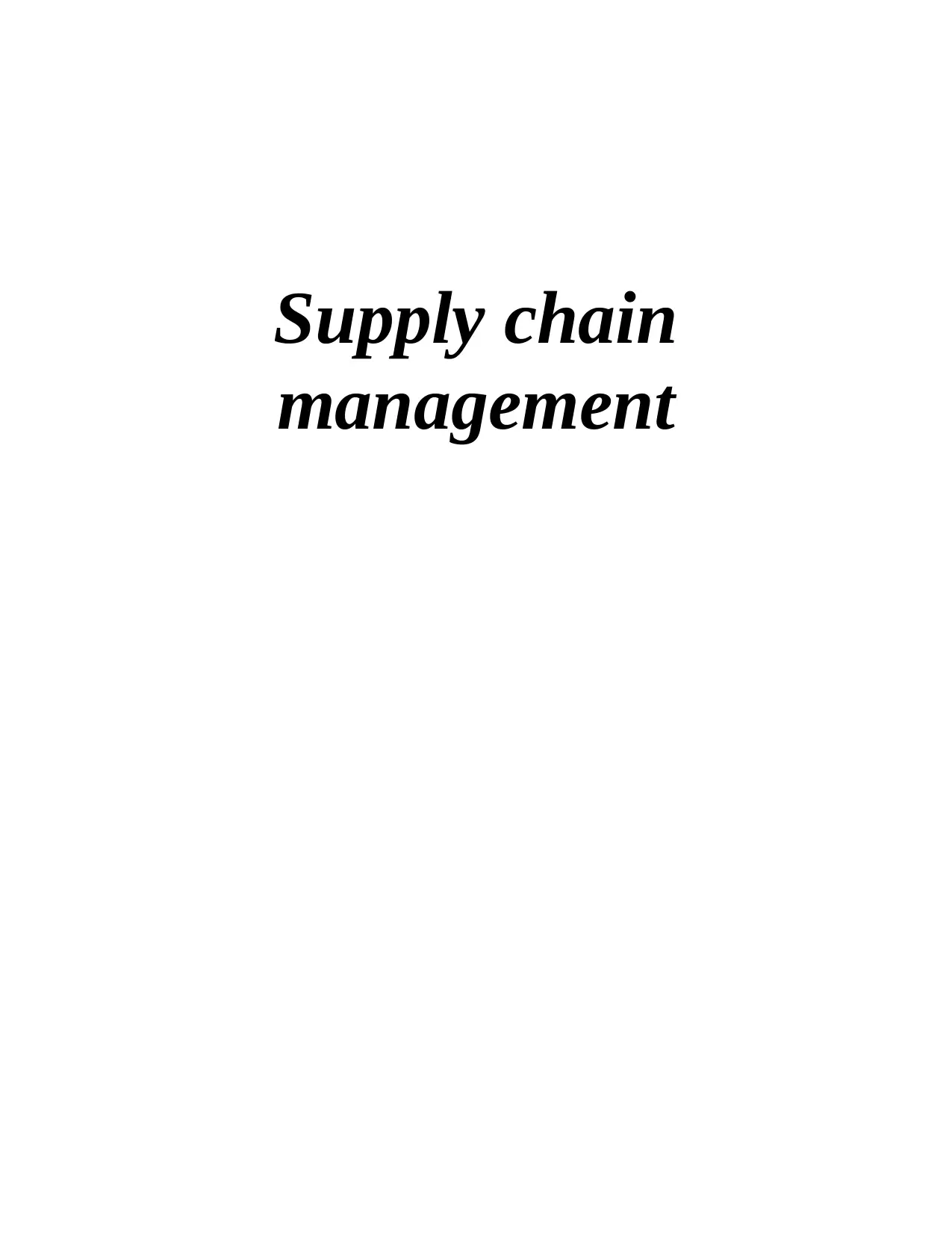
Supply chain
management
management
Paraphrase This Document
Need a fresh take? Get an instant paraphrase of this document with our AI Paraphraser
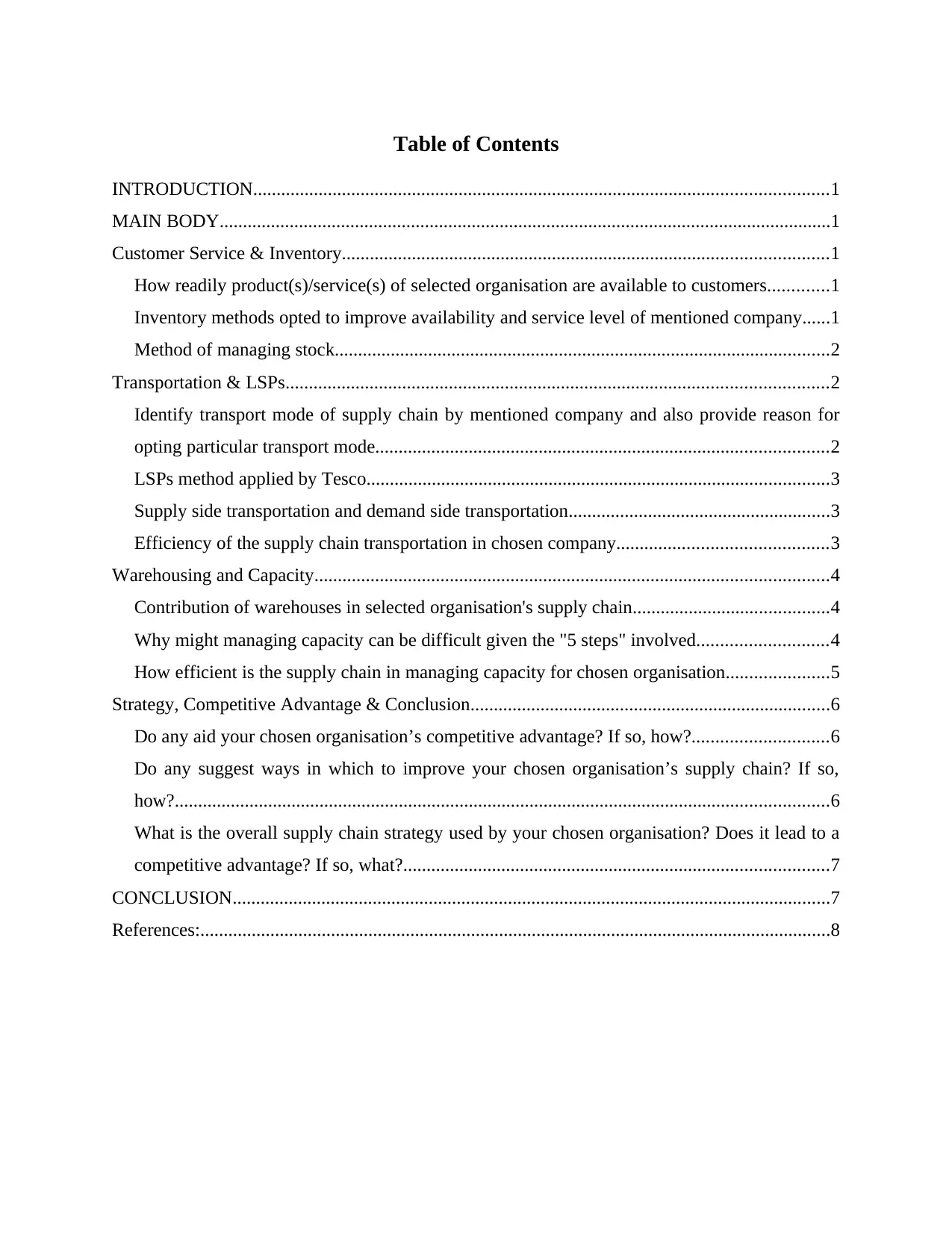
Table of Contents
INTRODUCTION...........................................................................................................................1
MAIN BODY...................................................................................................................................1
Customer Service & Inventory........................................................................................................1
How readily product(s)/service(s) of selected organisation are available to customers.............1
Inventory methods opted to improve availability and service level of mentioned company......1
Method of managing stock..........................................................................................................2
Transportation & LSPs....................................................................................................................2
Identify transport mode of supply chain by mentioned company and also provide reason for
opting particular transport mode.................................................................................................2
LSPs method applied by Tesco...................................................................................................3
Supply side transportation and demand side transportation........................................................3
Efficiency of the supply chain transportation in chosen company.............................................3
Warehousing and Capacity..............................................................................................................4
Contribution of warehouses in selected organisation's supply chain..........................................4
Why might managing capacity can be difficult given the "5 steps" involved............................4
How efficient is the supply chain in managing capacity for chosen organisation......................5
Strategy, Competitive Advantage & Conclusion.............................................................................6
Do any aid your chosen organisation’s competitive advantage? If so, how?.............................6
Do any suggest ways in which to improve your chosen organisation’s supply chain? If so,
how?............................................................................................................................................6
What is the overall supply chain strategy used by your chosen organisation? Does it lead to a
competitive advantage? If so, what?...........................................................................................7
CONCLUSION................................................................................................................................7
References:.......................................................................................................................................8
INTRODUCTION...........................................................................................................................1
MAIN BODY...................................................................................................................................1
Customer Service & Inventory........................................................................................................1
How readily product(s)/service(s) of selected organisation are available to customers.............1
Inventory methods opted to improve availability and service level of mentioned company......1
Method of managing stock..........................................................................................................2
Transportation & LSPs....................................................................................................................2
Identify transport mode of supply chain by mentioned company and also provide reason for
opting particular transport mode.................................................................................................2
LSPs method applied by Tesco...................................................................................................3
Supply side transportation and demand side transportation........................................................3
Efficiency of the supply chain transportation in chosen company.............................................3
Warehousing and Capacity..............................................................................................................4
Contribution of warehouses in selected organisation's supply chain..........................................4
Why might managing capacity can be difficult given the "5 steps" involved............................4
How efficient is the supply chain in managing capacity for chosen organisation......................5
Strategy, Competitive Advantage & Conclusion.............................................................................6
Do any aid your chosen organisation’s competitive advantage? If so, how?.............................6
Do any suggest ways in which to improve your chosen organisation’s supply chain? If so,
how?............................................................................................................................................6
What is the overall supply chain strategy used by your chosen organisation? Does it lead to a
competitive advantage? If so, what?...........................................................................................7
CONCLUSION................................................................................................................................7
References:.......................................................................................................................................8
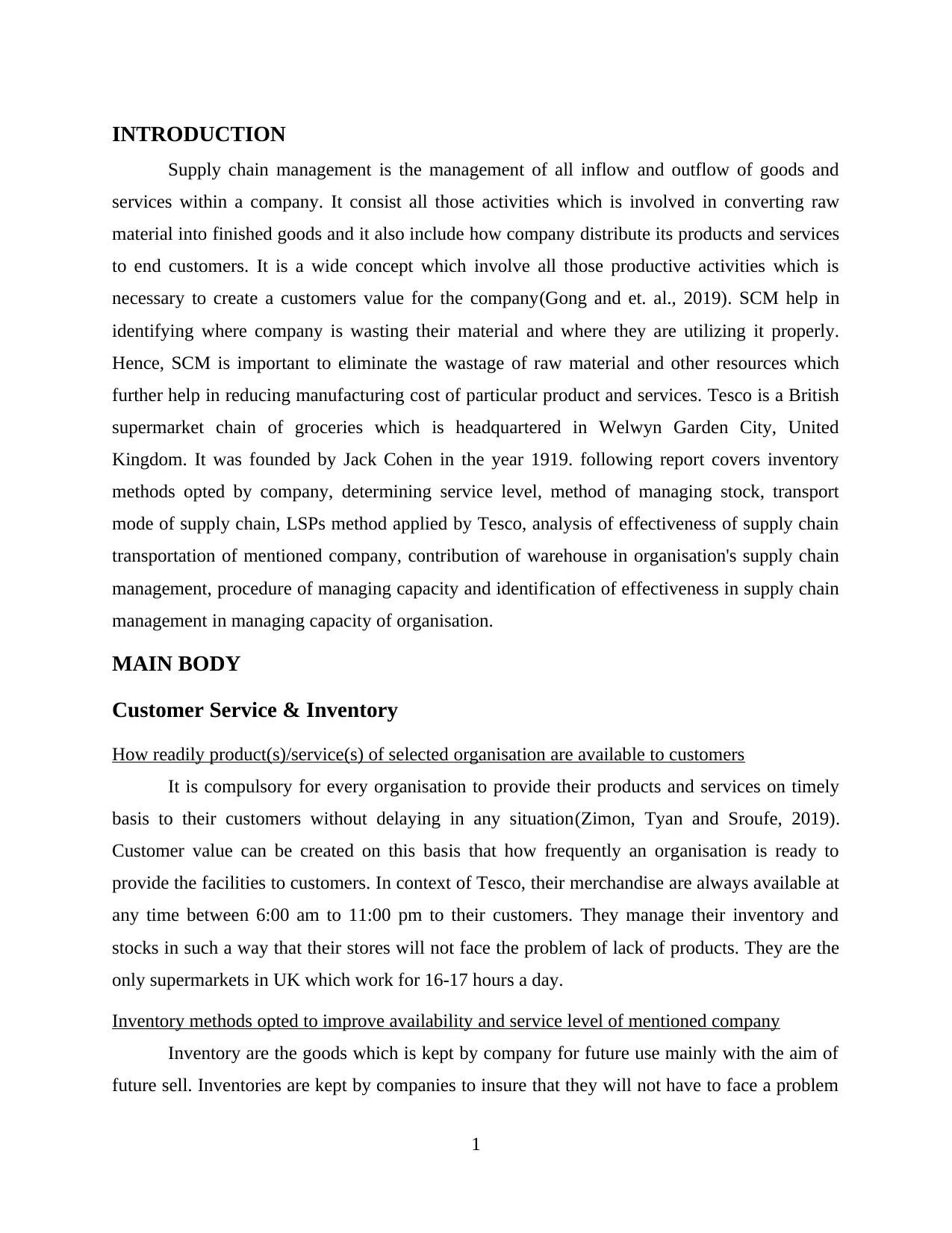
INTRODUCTION
Supply chain management is the management of all inflow and outflow of goods and
services within a company. It consist all those activities which is involved in converting raw
material into finished goods and it also include how company distribute its products and services
to end customers. It is a wide concept which involve all those productive activities which is
necessary to create a customers value for the company(Gong and et. al., 2019). SCM help in
identifying where company is wasting their material and where they are utilizing it properly.
Hence, SCM is important to eliminate the wastage of raw material and other resources which
further help in reducing manufacturing cost of particular product and services. Tesco is a British
supermarket chain of groceries which is headquartered in Welwyn Garden City, United
Kingdom. It was founded by Jack Cohen in the year 1919. following report covers inventory
methods opted by company, determining service level, method of managing stock, transport
mode of supply chain, LSPs method applied by Tesco, analysis of effectiveness of supply chain
transportation of mentioned company, contribution of warehouse in organisation's supply chain
management, procedure of managing capacity and identification of effectiveness in supply chain
management in managing capacity of organisation.
MAIN BODY
Customer Service & Inventory
How readily product(s)/service(s) of selected organisation are available to customers
It is compulsory for every organisation to provide their products and services on timely
basis to their customers without delaying in any situation(Zimon, Tyan and Sroufe, 2019).
Customer value can be created on this basis that how frequently an organisation is ready to
provide the facilities to customers. In context of Tesco, their merchandise are always available at
any time between 6:00 am to 11:00 pm to their customers. They manage their inventory and
stocks in such a way that their stores will not face the problem of lack of products. They are the
only supermarkets in UK which work for 16-17 hours a day.
Inventory methods opted to improve availability and service level of mentioned company
Inventory are the goods which is kept by company for future use mainly with the aim of
future sell. Inventories are kept by companies to insure that they will not have to face a problem
1
Supply chain management is the management of all inflow and outflow of goods and
services within a company. It consist all those activities which is involved in converting raw
material into finished goods and it also include how company distribute its products and services
to end customers. It is a wide concept which involve all those productive activities which is
necessary to create a customers value for the company(Gong and et. al., 2019). SCM help in
identifying where company is wasting their material and where they are utilizing it properly.
Hence, SCM is important to eliminate the wastage of raw material and other resources which
further help in reducing manufacturing cost of particular product and services. Tesco is a British
supermarket chain of groceries which is headquartered in Welwyn Garden City, United
Kingdom. It was founded by Jack Cohen in the year 1919. following report covers inventory
methods opted by company, determining service level, method of managing stock, transport
mode of supply chain, LSPs method applied by Tesco, analysis of effectiveness of supply chain
transportation of mentioned company, contribution of warehouse in organisation's supply chain
management, procedure of managing capacity and identification of effectiveness in supply chain
management in managing capacity of organisation.
MAIN BODY
Customer Service & Inventory
How readily product(s)/service(s) of selected organisation are available to customers
It is compulsory for every organisation to provide their products and services on timely
basis to their customers without delaying in any situation(Zimon, Tyan and Sroufe, 2019).
Customer value can be created on this basis that how frequently an organisation is ready to
provide the facilities to customers. In context of Tesco, their merchandise are always available at
any time between 6:00 am to 11:00 pm to their customers. They manage their inventory and
stocks in such a way that their stores will not face the problem of lack of products. They are the
only supermarkets in UK which work for 16-17 hours a day.
Inventory methods opted to improve availability and service level of mentioned company
Inventory are the goods which is kept by company for future use mainly with the aim of
future sell. Inventories are kept by companies to insure that they will not have to face a problem
1
⊘ This is a preview!⊘
Do you want full access?
Subscribe today to unlock all pages.

Trusted by 1+ million students worldwide
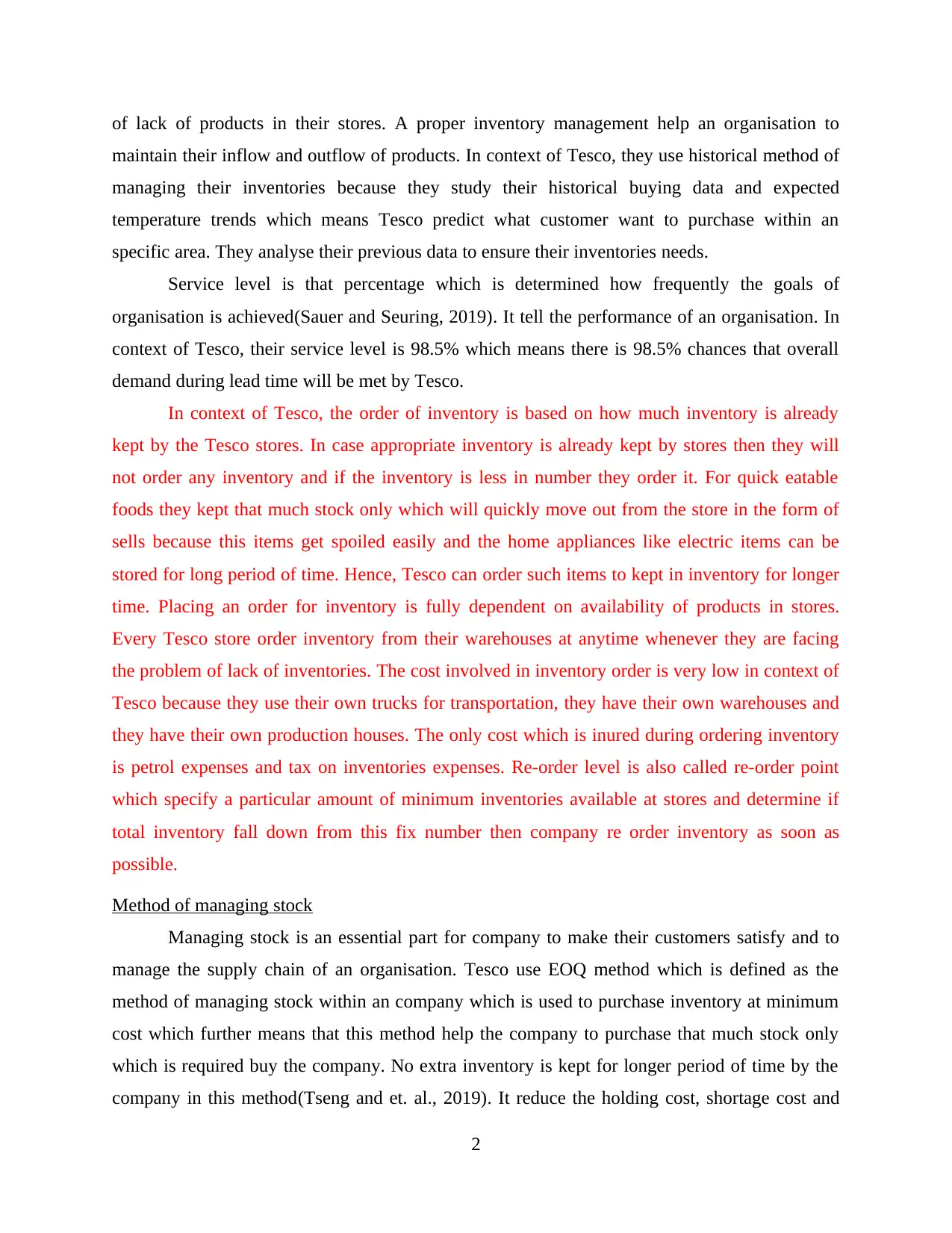
of lack of products in their stores. A proper inventory management help an organisation to
maintain their inflow and outflow of products. In context of Tesco, they use historical method of
managing their inventories because they study their historical buying data and expected
temperature trends which means Tesco predict what customer want to purchase within an
specific area. They analyse their previous data to ensure their inventories needs.
Service level is that percentage which is determined how frequently the goals of
organisation is achieved(Sauer and Seuring, 2019). It tell the performance of an organisation. In
context of Tesco, their service level is 98.5% which means there is 98.5% chances that overall
demand during lead time will be met by Tesco.
In context of Tesco, the order of inventory is based on how much inventory is already
kept by the Tesco stores. In case appropriate inventory is already kept by stores then they will
not order any inventory and if the inventory is less in number they order it. For quick eatable
foods they kept that much stock only which will quickly move out from the store in the form of
sells because this items get spoiled easily and the home appliances like electric items can be
stored for long period of time. Hence, Tesco can order such items to kept in inventory for longer
time. Placing an order for inventory is fully dependent on availability of products in stores.
Every Tesco store order inventory from their warehouses at anytime whenever they are facing
the problem of lack of inventories. The cost involved in inventory order is very low in context of
Tesco because they use their own trucks for transportation, they have their own warehouses and
they have their own production houses. The only cost which is inured during ordering inventory
is petrol expenses and tax on inventories expenses. Re-order level is also called re-order point
which specify a particular amount of minimum inventories available at stores and determine if
total inventory fall down from this fix number then company re order inventory as soon as
possible.
Method of managing stock
Managing stock is an essential part for company to make their customers satisfy and to
manage the supply chain of an organisation. Tesco use EOQ method which is defined as the
method of managing stock within an company which is used to purchase inventory at minimum
cost which further means that this method help the company to purchase that much stock only
which is required buy the company. No extra inventory is kept for longer period of time by the
company in this method(Tseng and et. al., 2019). It reduce the holding cost, shortage cost and
2
maintain their inflow and outflow of products. In context of Tesco, they use historical method of
managing their inventories because they study their historical buying data and expected
temperature trends which means Tesco predict what customer want to purchase within an
specific area. They analyse their previous data to ensure their inventories needs.
Service level is that percentage which is determined how frequently the goals of
organisation is achieved(Sauer and Seuring, 2019). It tell the performance of an organisation. In
context of Tesco, their service level is 98.5% which means there is 98.5% chances that overall
demand during lead time will be met by Tesco.
In context of Tesco, the order of inventory is based on how much inventory is already
kept by the Tesco stores. In case appropriate inventory is already kept by stores then they will
not order any inventory and if the inventory is less in number they order it. For quick eatable
foods they kept that much stock only which will quickly move out from the store in the form of
sells because this items get spoiled easily and the home appliances like electric items can be
stored for long period of time. Hence, Tesco can order such items to kept in inventory for longer
time. Placing an order for inventory is fully dependent on availability of products in stores.
Every Tesco store order inventory from their warehouses at anytime whenever they are facing
the problem of lack of inventories. The cost involved in inventory order is very low in context of
Tesco because they use their own trucks for transportation, they have their own warehouses and
they have their own production houses. The only cost which is inured during ordering inventory
is petrol expenses and tax on inventories expenses. Re-order level is also called re-order point
which specify a particular amount of minimum inventories available at stores and determine if
total inventory fall down from this fix number then company re order inventory as soon as
possible.
Method of managing stock
Managing stock is an essential part for company to make their customers satisfy and to
manage the supply chain of an organisation. Tesco use EOQ method which is defined as the
method of managing stock within an company which is used to purchase inventory at minimum
cost which further means that this method help the company to purchase that much stock only
which is required buy the company. No extra inventory is kept for longer period of time by the
company in this method(Tseng and et. al., 2019). It reduce the holding cost, shortage cost and
2
Paraphrase This Document
Need a fresh take? Get an instant paraphrase of this document with our AI Paraphraser
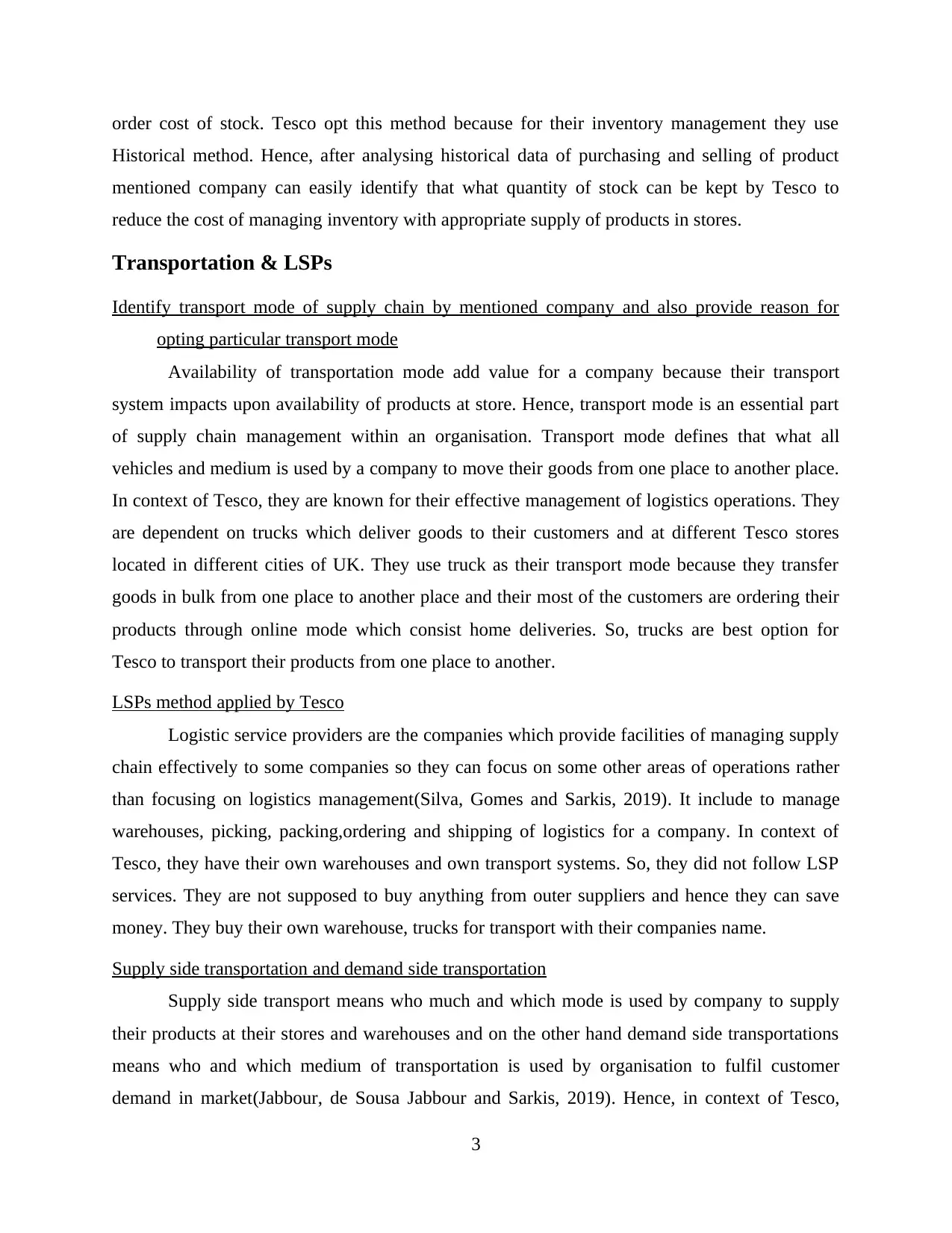
order cost of stock. Tesco opt this method because for their inventory management they use
Historical method. Hence, after analysing historical data of purchasing and selling of product
mentioned company can easily identify that what quantity of stock can be kept by Tesco to
reduce the cost of managing inventory with appropriate supply of products in stores.
Transportation & LSPs
Identify transport mode of supply chain by mentioned company and also provide reason for
opting particular transport mode
Availability of transportation mode add value for a company because their transport
system impacts upon availability of products at store. Hence, transport mode is an essential part
of supply chain management within an organisation. Transport mode defines that what all
vehicles and medium is used by a company to move their goods from one place to another place.
In context of Tesco, they are known for their effective management of logistics operations. They
are dependent on trucks which deliver goods to their customers and at different Tesco stores
located in different cities of UK. They use truck as their transport mode because they transfer
goods in bulk from one place to another place and their most of the customers are ordering their
products through online mode which consist home deliveries. So, trucks are best option for
Tesco to transport their products from one place to another.
LSPs method applied by Tesco
Logistic service providers are the companies which provide facilities of managing supply
chain effectively to some companies so they can focus on some other areas of operations rather
than focusing on logistics management(Silva, Gomes and Sarkis, 2019). It include to manage
warehouses, picking, packing,ordering and shipping of logistics for a company. In context of
Tesco, they have their own warehouses and own transport systems. So, they did not follow LSP
services. They are not supposed to buy anything from outer suppliers and hence they can save
money. They buy their own warehouse, trucks for transport with their companies name.
Supply side transportation and demand side transportation
Supply side transport means who much and which mode is used by company to supply
their products at their stores and warehouses and on the other hand demand side transportations
means who and which medium of transportation is used by organisation to fulfil customer
demand in market(Jabbour, de Sousa Jabbour and Sarkis, 2019). Hence, in context of Tesco,
3
Historical method. Hence, after analysing historical data of purchasing and selling of product
mentioned company can easily identify that what quantity of stock can be kept by Tesco to
reduce the cost of managing inventory with appropriate supply of products in stores.
Transportation & LSPs
Identify transport mode of supply chain by mentioned company and also provide reason for
opting particular transport mode
Availability of transportation mode add value for a company because their transport
system impacts upon availability of products at store. Hence, transport mode is an essential part
of supply chain management within an organisation. Transport mode defines that what all
vehicles and medium is used by a company to move their goods from one place to another place.
In context of Tesco, they are known for their effective management of logistics operations. They
are dependent on trucks which deliver goods to their customers and at different Tesco stores
located in different cities of UK. They use truck as their transport mode because they transfer
goods in bulk from one place to another place and their most of the customers are ordering their
products through online mode which consist home deliveries. So, trucks are best option for
Tesco to transport their products from one place to another.
LSPs method applied by Tesco
Logistic service providers are the companies which provide facilities of managing supply
chain effectively to some companies so they can focus on some other areas of operations rather
than focusing on logistics management(Silva, Gomes and Sarkis, 2019). It include to manage
warehouses, picking, packing,ordering and shipping of logistics for a company. In context of
Tesco, they have their own warehouses and own transport systems. So, they did not follow LSP
services. They are not supposed to buy anything from outer suppliers and hence they can save
money. They buy their own warehouse, trucks for transport with their companies name.
Supply side transportation and demand side transportation
Supply side transport means who much and which mode is used by company to supply
their products at their stores and warehouses and on the other hand demand side transportations
means who and which medium of transportation is used by organisation to fulfil customer
demand in market(Jabbour, de Sousa Jabbour and Sarkis, 2019). Hence, in context of Tesco,
3
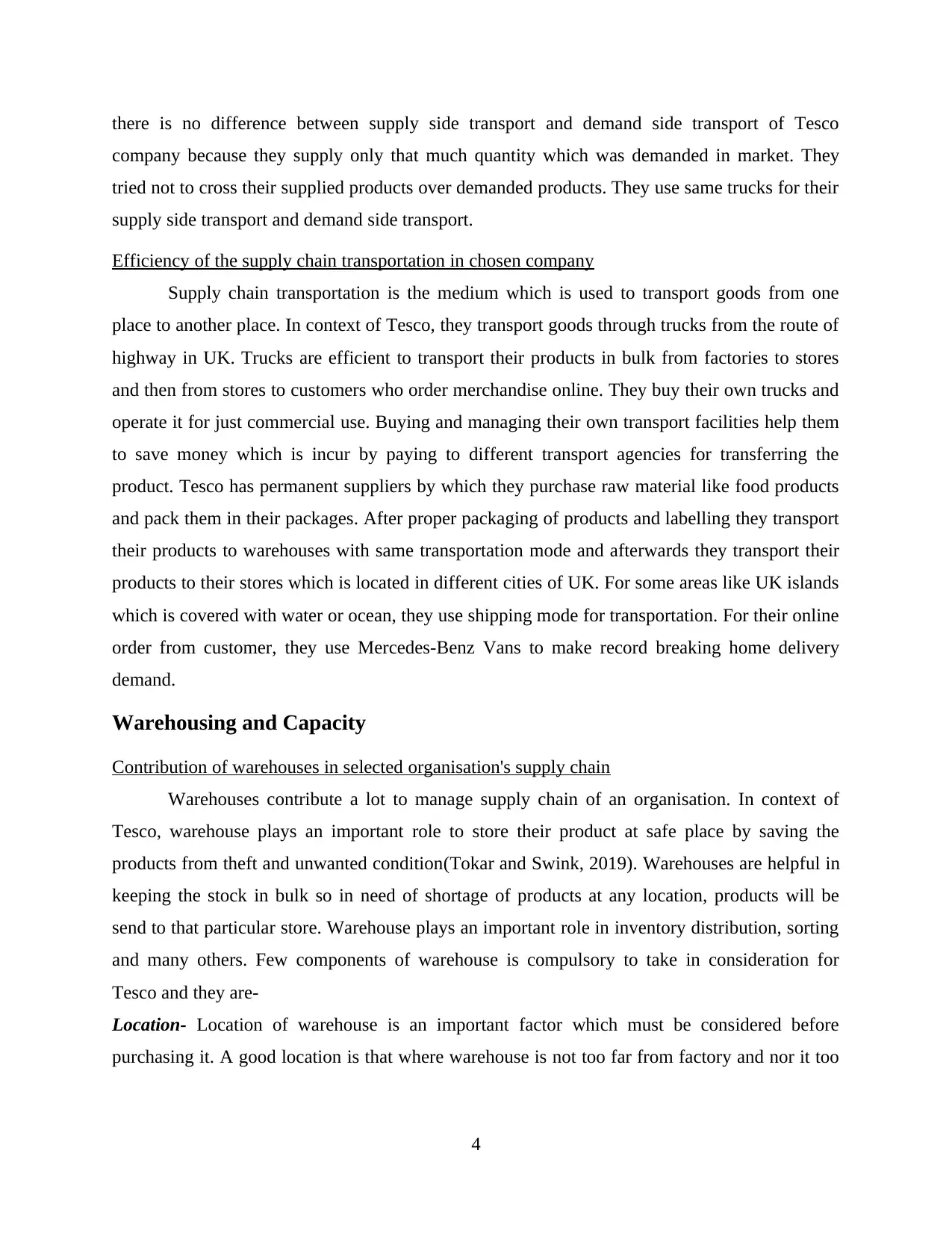
there is no difference between supply side transport and demand side transport of Tesco
company because they supply only that much quantity which was demanded in market. They
tried not to cross their supplied products over demanded products. They use same trucks for their
supply side transport and demand side transport.
Efficiency of the supply chain transportation in chosen company
Supply chain transportation is the medium which is used to transport goods from one
place to another place. In context of Tesco, they transport goods through trucks from the route of
highway in UK. Trucks are efficient to transport their products in bulk from factories to stores
and then from stores to customers who order merchandise online. They buy their own trucks and
operate it for just commercial use. Buying and managing their own transport facilities help them
to save money which is incur by paying to different transport agencies for transferring the
product. Tesco has permanent suppliers by which they purchase raw material like food products
and pack them in their packages. After proper packaging of products and labelling they transport
their products to warehouses with same transportation mode and afterwards they transport their
products to their stores which is located in different cities of UK. For some areas like UK islands
which is covered with water or ocean, they use shipping mode for transportation. For their online
order from customer, they use Mercedes-Benz Vans to make record breaking home delivery
demand.
Warehousing and Capacity
Contribution of warehouses in selected organisation's supply chain
Warehouses contribute a lot to manage supply chain of an organisation. In context of
Tesco, warehouse plays an important role to store their product at safe place by saving the
products from theft and unwanted condition(Tokar and Swink, 2019). Warehouses are helpful in
keeping the stock in bulk so in need of shortage of products at any location, products will be
send to that particular store. Warehouse plays an important role in inventory distribution, sorting
and many others. Few components of warehouse is compulsory to take in consideration for
Tesco and they are-
Location- Location of warehouse is an important factor which must be considered before
purchasing it. A good location is that where warehouse is not too far from factory and nor it too
4
company because they supply only that much quantity which was demanded in market. They
tried not to cross their supplied products over demanded products. They use same trucks for their
supply side transport and demand side transport.
Efficiency of the supply chain transportation in chosen company
Supply chain transportation is the medium which is used to transport goods from one
place to another place. In context of Tesco, they transport goods through trucks from the route of
highway in UK. Trucks are efficient to transport their products in bulk from factories to stores
and then from stores to customers who order merchandise online. They buy their own trucks and
operate it for just commercial use. Buying and managing their own transport facilities help them
to save money which is incur by paying to different transport agencies for transferring the
product. Tesco has permanent suppliers by which they purchase raw material like food products
and pack them in their packages. After proper packaging of products and labelling they transport
their products to warehouses with same transportation mode and afterwards they transport their
products to their stores which is located in different cities of UK. For some areas like UK islands
which is covered with water or ocean, they use shipping mode for transportation. For their online
order from customer, they use Mercedes-Benz Vans to make record breaking home delivery
demand.
Warehousing and Capacity
Contribution of warehouses in selected organisation's supply chain
Warehouses contribute a lot to manage supply chain of an organisation. In context of
Tesco, warehouse plays an important role to store their product at safe place by saving the
products from theft and unwanted condition(Tokar and Swink, 2019). Warehouses are helpful in
keeping the stock in bulk so in need of shortage of products at any location, products will be
send to that particular store. Warehouse plays an important role in inventory distribution, sorting
and many others. Few components of warehouse is compulsory to take in consideration for
Tesco and they are-
Location- Location of warehouse is an important factor which must be considered before
purchasing it. A good location is that where warehouse is not too far from factory and nor it too
4
⊘ This is a preview!⊘
Do you want full access?
Subscribe today to unlock all pages.

Trusted by 1+ million students worldwide
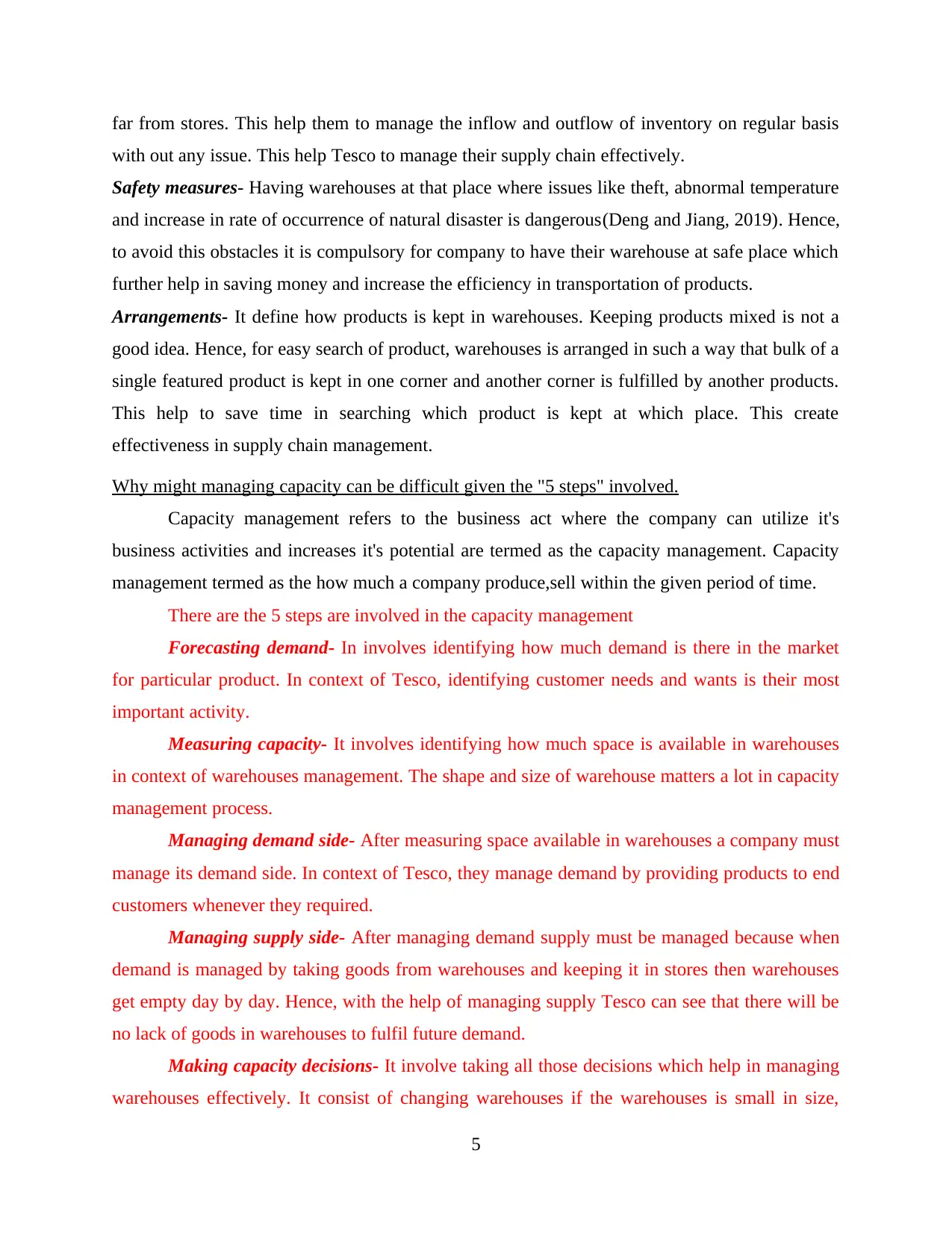
far from stores. This help them to manage the inflow and outflow of inventory on regular basis
with out any issue. This help Tesco to manage their supply chain effectively.
Safety measures- Having warehouses at that place where issues like theft, abnormal temperature
and increase in rate of occurrence of natural disaster is dangerous(Deng and Jiang, 2019). Hence,
to avoid this obstacles it is compulsory for company to have their warehouse at safe place which
further help in saving money and increase the efficiency in transportation of products.
Arrangements- It define how products is kept in warehouses. Keeping products mixed is not a
good idea. Hence, for easy search of product, warehouses is arranged in such a way that bulk of a
single featured product is kept in one corner and another corner is fulfilled by another products.
This help to save time in searching which product is kept at which place. This create
effectiveness in supply chain management.
Why might managing capacity can be difficult given the "5 steps" involved.
Capacity management refers to the business act where the company can utilize it's
business activities and increases it's potential are termed as the capacity management. Capacity
management termed as the how much a company produce,sell within the given period of time.
There are the 5 steps are involved in the capacity management
Forecasting demand- In involves identifying how much demand is there in the market
for particular product. In context of Tesco, identifying customer needs and wants is their most
important activity.
Measuring capacity- It involves identifying how much space is available in warehouses
in context of warehouses management. The shape and size of warehouse matters a lot in capacity
management process.
Managing demand side- After measuring space available in warehouses a company must
manage its demand side. In context of Tesco, they manage demand by providing products to end
customers whenever they required.
Managing supply side- After managing demand supply must be managed because when
demand is managed by taking goods from warehouses and keeping it in stores then warehouses
get empty day by day. Hence, with the help of managing supply Tesco can see that there will be
no lack of goods in warehouses to fulfil future demand.
Making capacity decisions- It involve taking all those decisions which help in managing
warehouses effectively. It consist of changing warehouses if the warehouses is small in size,
5
with out any issue. This help Tesco to manage their supply chain effectively.
Safety measures- Having warehouses at that place where issues like theft, abnormal temperature
and increase in rate of occurrence of natural disaster is dangerous(Deng and Jiang, 2019). Hence,
to avoid this obstacles it is compulsory for company to have their warehouse at safe place which
further help in saving money and increase the efficiency in transportation of products.
Arrangements- It define how products is kept in warehouses. Keeping products mixed is not a
good idea. Hence, for easy search of product, warehouses is arranged in such a way that bulk of a
single featured product is kept in one corner and another corner is fulfilled by another products.
This help to save time in searching which product is kept at which place. This create
effectiveness in supply chain management.
Why might managing capacity can be difficult given the "5 steps" involved.
Capacity management refers to the business act where the company can utilize it's
business activities and increases it's potential are termed as the capacity management. Capacity
management termed as the how much a company produce,sell within the given period of time.
There are the 5 steps are involved in the capacity management
Forecasting demand- In involves identifying how much demand is there in the market
for particular product. In context of Tesco, identifying customer needs and wants is their most
important activity.
Measuring capacity- It involves identifying how much space is available in warehouses
in context of warehouses management. The shape and size of warehouse matters a lot in capacity
management process.
Managing demand side- After measuring space available in warehouses a company must
manage its demand side. In context of Tesco, they manage demand by providing products to end
customers whenever they required.
Managing supply side- After managing demand supply must be managed because when
demand is managed by taking goods from warehouses and keeping it in stores then warehouses
get empty day by day. Hence, with the help of managing supply Tesco can see that there will be
no lack of goods in warehouses to fulfil future demand.
Making capacity decisions- It involve taking all those decisions which help in managing
warehouses effectively. It consist of changing warehouses if the warehouses is small in size,
5
Paraphrase This Document
Need a fresh take? Get an instant paraphrase of this document with our AI Paraphraser
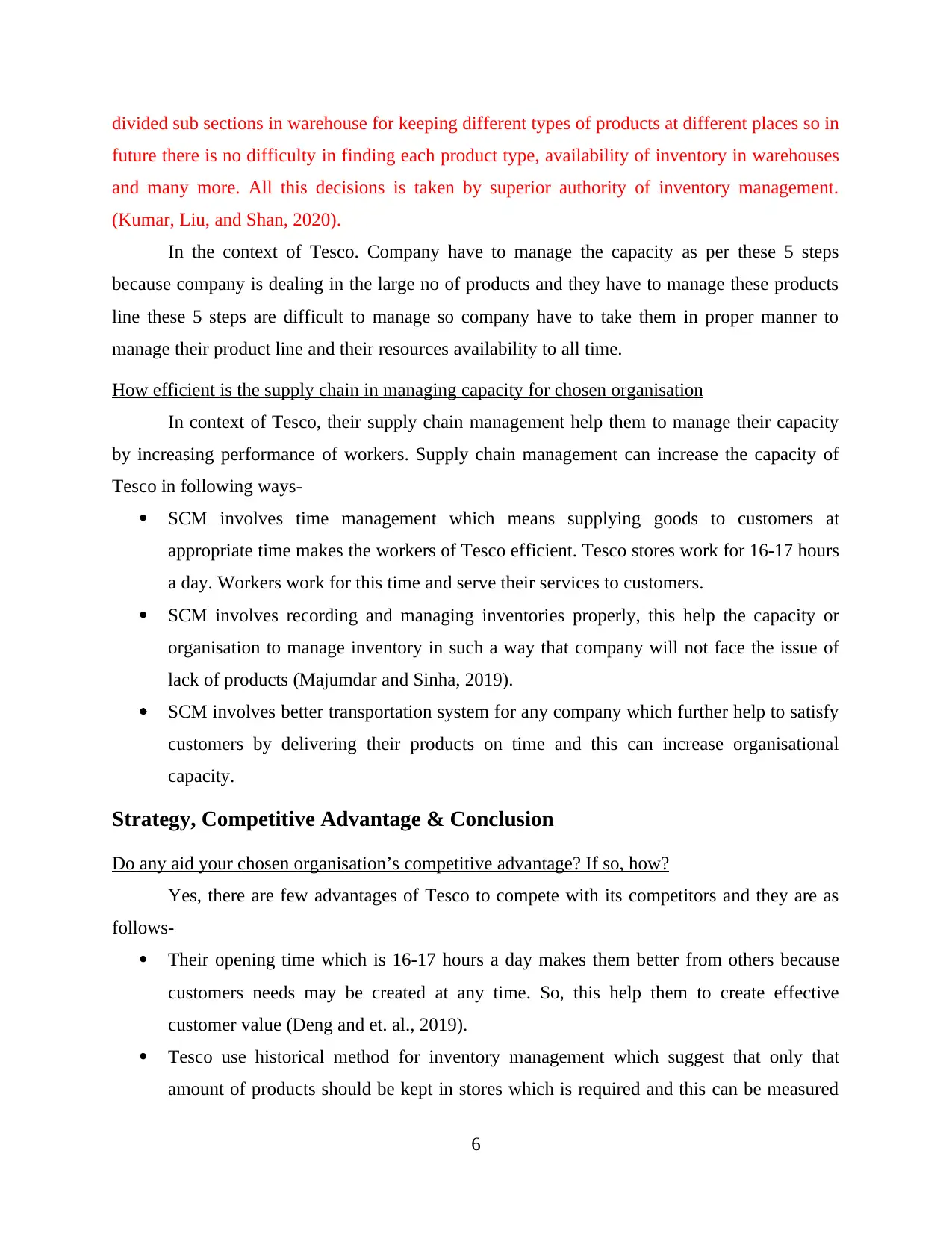
divided sub sections in warehouse for keeping different types of products at different places so in
future there is no difficulty in finding each product type, availability of inventory in warehouses
and many more. All this decisions is taken by superior authority of inventory management.
(Kumar, Liu, and Shan, 2020).
In the context of Tesco. Company have to manage the capacity as per these 5 steps
because company is dealing in the large no of products and they have to manage these products
line these 5 steps are difficult to manage so company have to take them in proper manner to
manage their product line and their resources availability to all time.
How efficient is the supply chain in managing capacity for chosen organisation
In context of Tesco, their supply chain management help them to manage their capacity
by increasing performance of workers. Supply chain management can increase the capacity of
Tesco in following ways-
SCM involves time management which means supplying goods to customers at
appropriate time makes the workers of Tesco efficient. Tesco stores work for 16-17 hours
a day. Workers work for this time and serve their services to customers.
SCM involves recording and managing inventories properly, this help the capacity or
organisation to manage inventory in such a way that company will not face the issue of
lack of products (Majumdar and Sinha, 2019).
SCM involves better transportation system for any company which further help to satisfy
customers by delivering their products on time and this can increase organisational
capacity.
Strategy, Competitive Advantage & Conclusion
Do any aid your chosen organisation’s competitive advantage? If so, how?
Yes, there are few advantages of Tesco to compete with its competitors and they are as
follows-
Their opening time which is 16-17 hours a day makes them better from others because
customers needs may be created at any time. So, this help them to create effective
customer value (Deng and et. al., 2019).
Tesco use historical method for inventory management which suggest that only that
amount of products should be kept in stores which is required and this can be measured
6
future there is no difficulty in finding each product type, availability of inventory in warehouses
and many more. All this decisions is taken by superior authority of inventory management.
(Kumar, Liu, and Shan, 2020).
In the context of Tesco. Company have to manage the capacity as per these 5 steps
because company is dealing in the large no of products and they have to manage these products
line these 5 steps are difficult to manage so company have to take them in proper manner to
manage their product line and their resources availability to all time.
How efficient is the supply chain in managing capacity for chosen organisation
In context of Tesco, their supply chain management help them to manage their capacity
by increasing performance of workers. Supply chain management can increase the capacity of
Tesco in following ways-
SCM involves time management which means supplying goods to customers at
appropriate time makes the workers of Tesco efficient. Tesco stores work for 16-17 hours
a day. Workers work for this time and serve their services to customers.
SCM involves recording and managing inventories properly, this help the capacity or
organisation to manage inventory in such a way that company will not face the issue of
lack of products (Majumdar and Sinha, 2019).
SCM involves better transportation system for any company which further help to satisfy
customers by delivering their products on time and this can increase organisational
capacity.
Strategy, Competitive Advantage & Conclusion
Do any aid your chosen organisation’s competitive advantage? If so, how?
Yes, there are few advantages of Tesco to compete with its competitors and they are as
follows-
Their opening time which is 16-17 hours a day makes them better from others because
customers needs may be created at any time. So, this help them to create effective
customer value (Deng and et. al., 2019).
Tesco use historical method for inventory management which suggest that only that
amount of products should be kept in stores which is required and this can be measured
6
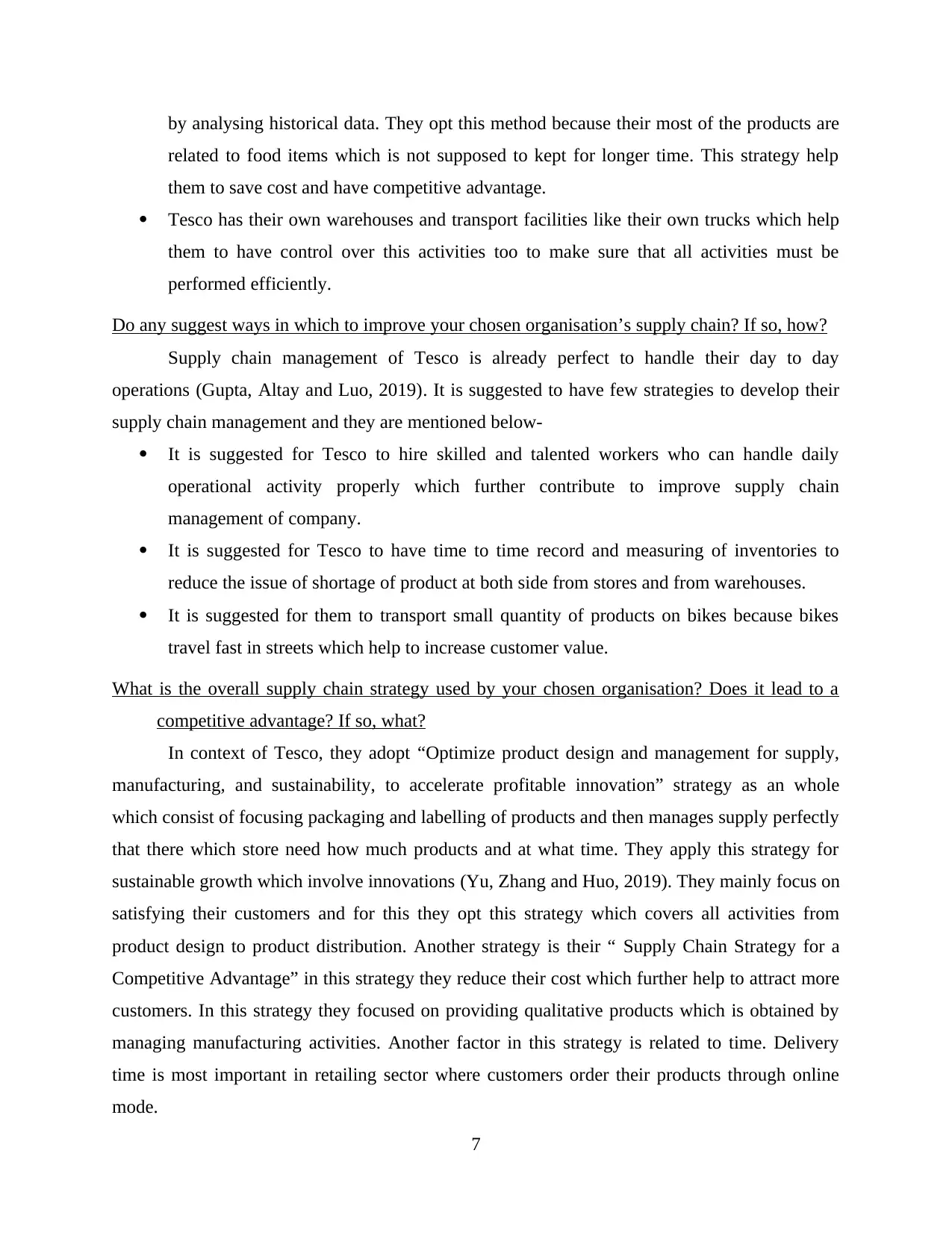
by analysing historical data. They opt this method because their most of the products are
related to food items which is not supposed to kept for longer time. This strategy help
them to save cost and have competitive advantage.
Tesco has their own warehouses and transport facilities like their own trucks which help
them to have control over this activities too to make sure that all activities must be
performed efficiently.
Do any suggest ways in which to improve your chosen organisation’s supply chain? If so, how?
Supply chain management of Tesco is already perfect to handle their day to day
operations (Gupta, Altay and Luo, 2019). It is suggested to have few strategies to develop their
supply chain management and they are mentioned below-
It is suggested for Tesco to hire skilled and talented workers who can handle daily
operational activity properly which further contribute to improve supply chain
management of company.
It is suggested for Tesco to have time to time record and measuring of inventories to
reduce the issue of shortage of product at both side from stores and from warehouses.
It is suggested for them to transport small quantity of products on bikes because bikes
travel fast in streets which help to increase customer value.
What is the overall supply chain strategy used by your chosen organisation? Does it lead to a
competitive advantage? If so, what?
In context of Tesco, they adopt “Optimize product design and management for supply,
manufacturing, and sustainability, to accelerate profitable innovation” strategy as an whole
which consist of focusing packaging and labelling of products and then manages supply perfectly
that there which store need how much products and at what time. They apply this strategy for
sustainable growth which involve innovations (Yu, Zhang and Huo, 2019). They mainly focus on
satisfying their customers and for this they opt this strategy which covers all activities from
product design to product distribution. Another strategy is their “ Supply Chain Strategy for a
Competitive Advantage” in this strategy they reduce their cost which further help to attract more
customers. In this strategy they focused on providing qualitative products which is obtained by
managing manufacturing activities. Another factor in this strategy is related to time. Delivery
time is most important in retailing sector where customers order their products through online
mode.
7
related to food items which is not supposed to kept for longer time. This strategy help
them to save cost and have competitive advantage.
Tesco has their own warehouses and transport facilities like their own trucks which help
them to have control over this activities too to make sure that all activities must be
performed efficiently.
Do any suggest ways in which to improve your chosen organisation’s supply chain? If so, how?
Supply chain management of Tesco is already perfect to handle their day to day
operations (Gupta, Altay and Luo, 2019). It is suggested to have few strategies to develop their
supply chain management and they are mentioned below-
It is suggested for Tesco to hire skilled and talented workers who can handle daily
operational activity properly which further contribute to improve supply chain
management of company.
It is suggested for Tesco to have time to time record and measuring of inventories to
reduce the issue of shortage of product at both side from stores and from warehouses.
It is suggested for them to transport small quantity of products on bikes because bikes
travel fast in streets which help to increase customer value.
What is the overall supply chain strategy used by your chosen organisation? Does it lead to a
competitive advantage? If so, what?
In context of Tesco, they adopt “Optimize product design and management for supply,
manufacturing, and sustainability, to accelerate profitable innovation” strategy as an whole
which consist of focusing packaging and labelling of products and then manages supply perfectly
that there which store need how much products and at what time. They apply this strategy for
sustainable growth which involve innovations (Yu, Zhang and Huo, 2019). They mainly focus on
satisfying their customers and for this they opt this strategy which covers all activities from
product design to product distribution. Another strategy is their “ Supply Chain Strategy for a
Competitive Advantage” in this strategy they reduce their cost which further help to attract more
customers. In this strategy they focused on providing qualitative products which is obtained by
managing manufacturing activities. Another factor in this strategy is related to time. Delivery
time is most important in retailing sector where customers order their products through online
mode.
7
⊘ This is a preview!⊘
Do you want full access?
Subscribe today to unlock all pages.

Trusted by 1+ million students worldwide
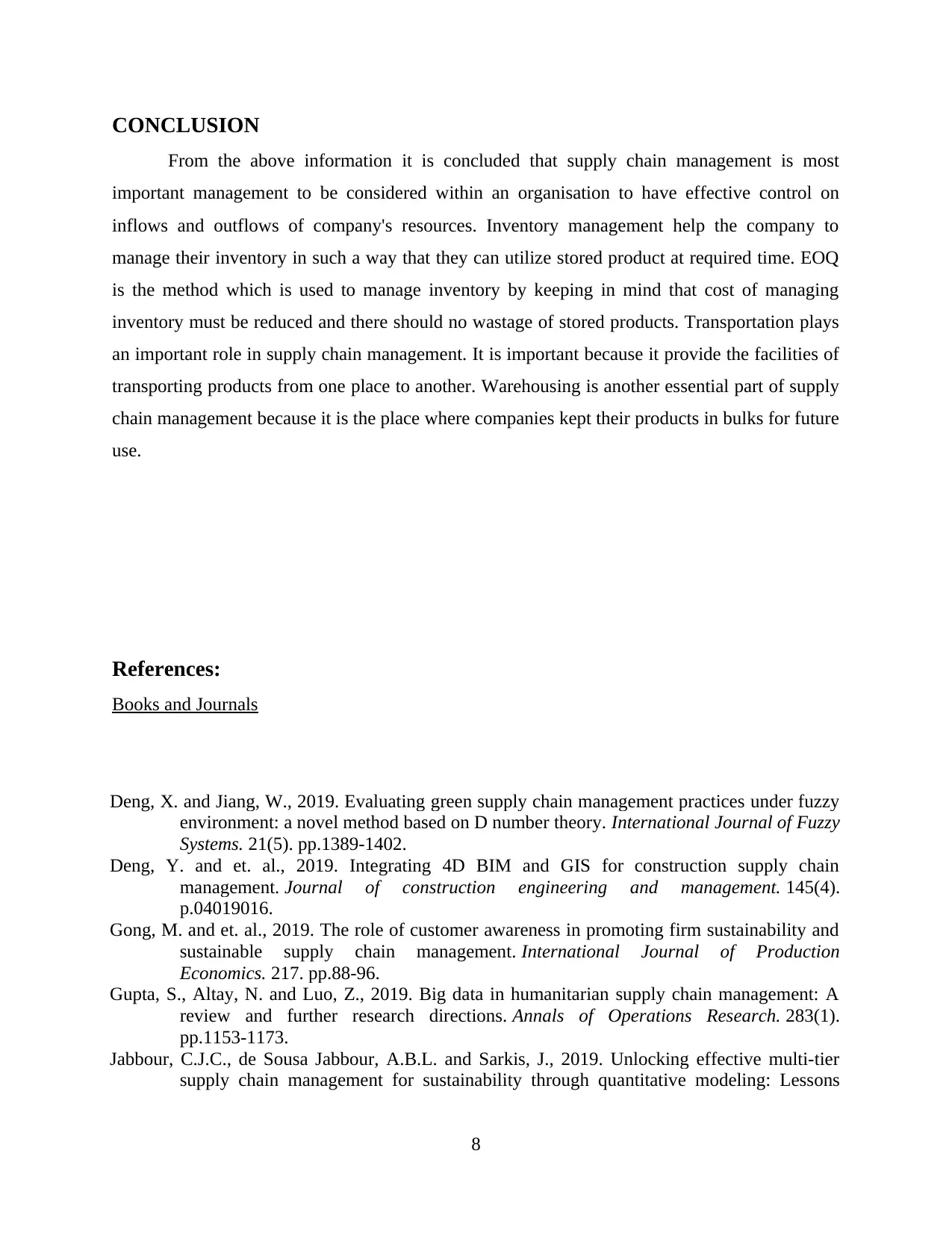
CONCLUSION
From the above information it is concluded that supply chain management is most
important management to be considered within an organisation to have effective control on
inflows and outflows of company's resources. Inventory management help the company to
manage their inventory in such a way that they can utilize stored product at required time. EOQ
is the method which is used to manage inventory by keeping in mind that cost of managing
inventory must be reduced and there should no wastage of stored products. Transportation plays
an important role in supply chain management. It is important because it provide the facilities of
transporting products from one place to another. Warehousing is another essential part of supply
chain management because it is the place where companies kept their products in bulks for future
use.
References:
Books and Journals
Deng, X. and Jiang, W., 2019. Evaluating green supply chain management practices under fuzzy
environment: a novel method based on D number theory. International Journal of Fuzzy
Systems. 21(5). pp.1389-1402.
Deng, Y. and et. al., 2019. Integrating 4D BIM and GIS for construction supply chain
management. Journal of construction engineering and management. 145(4).
p.04019016.
Gong, M. and et. al., 2019. The role of customer awareness in promoting firm sustainability and
sustainable supply chain management. International Journal of Production
Economics. 217. pp.88-96.
Gupta, S., Altay, N. and Luo, Z., 2019. Big data in humanitarian supply chain management: A
review and further research directions. Annals of Operations Research. 283(1).
pp.1153-1173.
Jabbour, C.J.C., de Sousa Jabbour, A.B.L. and Sarkis, J., 2019. Unlocking effective multi-tier
supply chain management for sustainability through quantitative modeling: Lessons
8
From the above information it is concluded that supply chain management is most
important management to be considered within an organisation to have effective control on
inflows and outflows of company's resources. Inventory management help the company to
manage their inventory in such a way that they can utilize stored product at required time. EOQ
is the method which is used to manage inventory by keeping in mind that cost of managing
inventory must be reduced and there should no wastage of stored products. Transportation plays
an important role in supply chain management. It is important because it provide the facilities of
transporting products from one place to another. Warehousing is another essential part of supply
chain management because it is the place where companies kept their products in bulks for future
use.
References:
Books and Journals
Deng, X. and Jiang, W., 2019. Evaluating green supply chain management practices under fuzzy
environment: a novel method based on D number theory. International Journal of Fuzzy
Systems. 21(5). pp.1389-1402.
Deng, Y. and et. al., 2019. Integrating 4D BIM and GIS for construction supply chain
management. Journal of construction engineering and management. 145(4).
p.04019016.
Gong, M. and et. al., 2019. The role of customer awareness in promoting firm sustainability and
sustainable supply chain management. International Journal of Production
Economics. 217. pp.88-96.
Gupta, S., Altay, N. and Luo, Z., 2019. Big data in humanitarian supply chain management: A
review and further research directions. Annals of Operations Research. 283(1).
pp.1153-1173.
Jabbour, C.J.C., de Sousa Jabbour, A.B.L. and Sarkis, J., 2019. Unlocking effective multi-tier
supply chain management for sustainability through quantitative modeling: Lessons
8
Paraphrase This Document
Need a fresh take? Get an instant paraphrase of this document with our AI Paraphraser
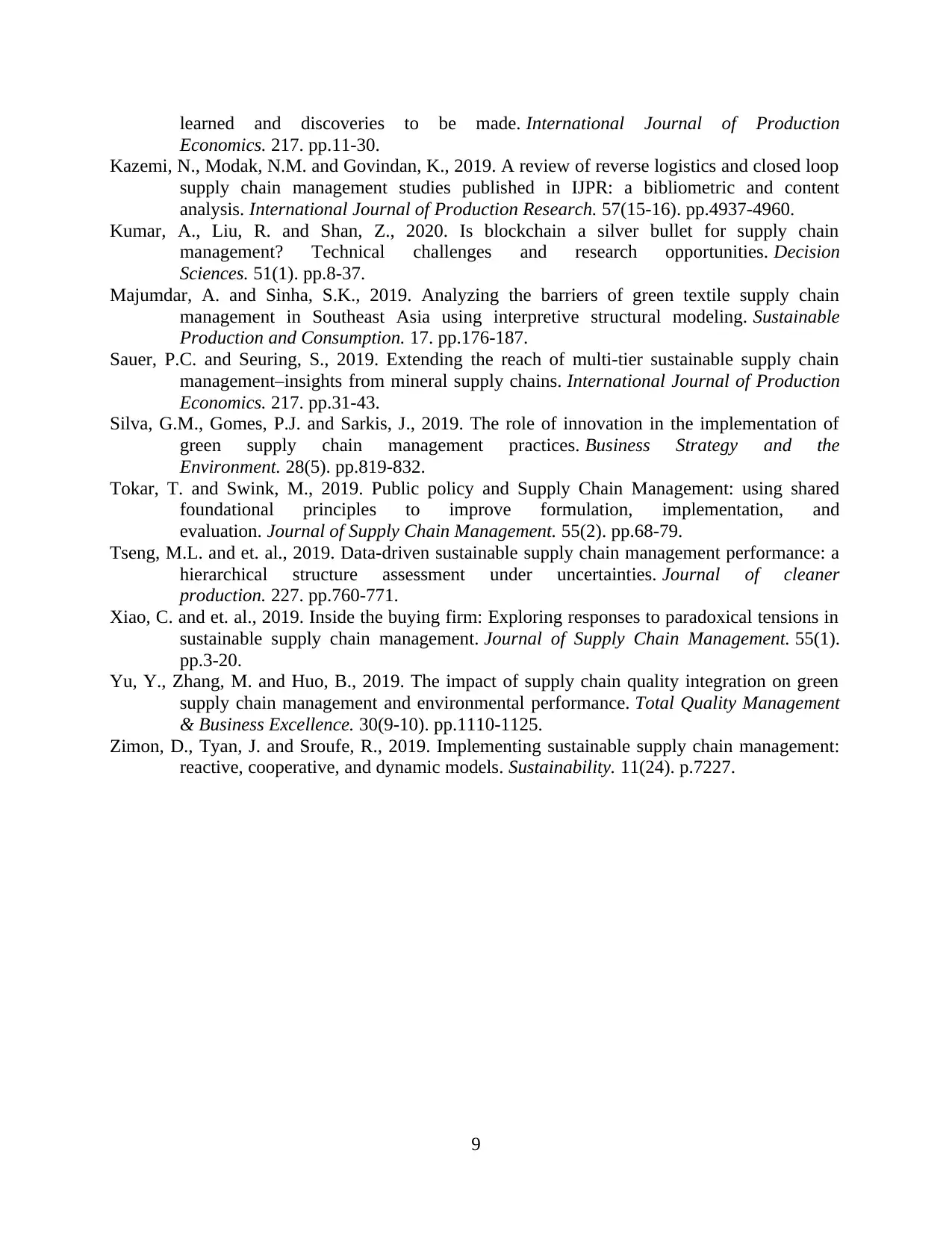
learned and discoveries to be made. International Journal of Production
Economics. 217. pp.11-30.
Kazemi, N., Modak, N.M. and Govindan, K., 2019. A review of reverse logistics and closed loop
supply chain management studies published in IJPR: a bibliometric and content
analysis. International Journal of Production Research. 57(15-16). pp.4937-4960.
Kumar, A., Liu, R. and Shan, Z., 2020. Is blockchain a silver bullet for supply chain
management? Technical challenges and research opportunities. Decision
Sciences. 51(1). pp.8-37.
Majumdar, A. and Sinha, S.K., 2019. Analyzing the barriers of green textile supply chain
management in Southeast Asia using interpretive structural modeling. Sustainable
Production and Consumption. 17. pp.176-187.
Sauer, P.C. and Seuring, S., 2019. Extending the reach of multi-tier sustainable supply chain
management–insights from mineral supply chains. International Journal of Production
Economics. 217. pp.31-43.
Silva, G.M., Gomes, P.J. and Sarkis, J., 2019. The role of innovation in the implementation of
green supply chain management practices. Business Strategy and the
Environment. 28(5). pp.819-832.
Tokar, T. and Swink, M., 2019. Public policy and Supply Chain Management: using shared
foundational principles to improve formulation, implementation, and
evaluation. Journal of Supply Chain Management. 55(2). pp.68-79.
Tseng, M.L. and et. al., 2019. Data-driven sustainable supply chain management performance: a
hierarchical structure assessment under uncertainties. Journal of cleaner
production. 227. pp.760-771.
Xiao, C. and et. al., 2019. Inside the buying firm: Exploring responses to paradoxical tensions in
sustainable supply chain management. Journal of Supply Chain Management. 55(1).
pp.3-20.
Yu, Y., Zhang, M. and Huo, B., 2019. The impact of supply chain quality integration on green
supply chain management and environmental performance. Total Quality Management
& Business Excellence. 30(9-10). pp.1110-1125.
Zimon, D., Tyan, J. and Sroufe, R., 2019. Implementing sustainable supply chain management:
reactive, cooperative, and dynamic models. Sustainability. 11(24). p.7227.
9
Economics. 217. pp.11-30.
Kazemi, N., Modak, N.M. and Govindan, K., 2019. A review of reverse logistics and closed loop
supply chain management studies published in IJPR: a bibliometric and content
analysis. International Journal of Production Research. 57(15-16). pp.4937-4960.
Kumar, A., Liu, R. and Shan, Z., 2020. Is blockchain a silver bullet for supply chain
management? Technical challenges and research opportunities. Decision
Sciences. 51(1). pp.8-37.
Majumdar, A. and Sinha, S.K., 2019. Analyzing the barriers of green textile supply chain
management in Southeast Asia using interpretive structural modeling. Sustainable
Production and Consumption. 17. pp.176-187.
Sauer, P.C. and Seuring, S., 2019. Extending the reach of multi-tier sustainable supply chain
management–insights from mineral supply chains. International Journal of Production
Economics. 217. pp.31-43.
Silva, G.M., Gomes, P.J. and Sarkis, J., 2019. The role of innovation in the implementation of
green supply chain management practices. Business Strategy and the
Environment. 28(5). pp.819-832.
Tokar, T. and Swink, M., 2019. Public policy and Supply Chain Management: using shared
foundational principles to improve formulation, implementation, and
evaluation. Journal of Supply Chain Management. 55(2). pp.68-79.
Tseng, M.L. and et. al., 2019. Data-driven sustainable supply chain management performance: a
hierarchical structure assessment under uncertainties. Journal of cleaner
production. 227. pp.760-771.
Xiao, C. and et. al., 2019. Inside the buying firm: Exploring responses to paradoxical tensions in
sustainable supply chain management. Journal of Supply Chain Management. 55(1).
pp.3-20.
Yu, Y., Zhang, M. and Huo, B., 2019. The impact of supply chain quality integration on green
supply chain management and environmental performance. Total Quality Management
& Business Excellence. 30(9-10). pp.1110-1125.
Zimon, D., Tyan, J. and Sroufe, R., 2019. Implementing sustainable supply chain management:
reactive, cooperative, and dynamic models. Sustainability. 11(24). p.7227.
9
1 out of 11
Related Documents
Your All-in-One AI-Powered Toolkit for Academic Success.
+13062052269
info@desklib.com
Available 24*7 on WhatsApp / Email
![[object Object]](/_next/static/media/star-bottom.7253800d.svg)
Unlock your academic potential
Copyright © 2020–2025 A2Z Services. All Rights Reserved. Developed and managed by ZUCOL.





